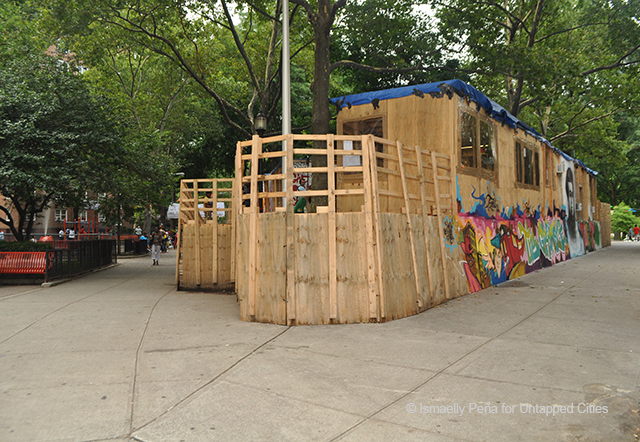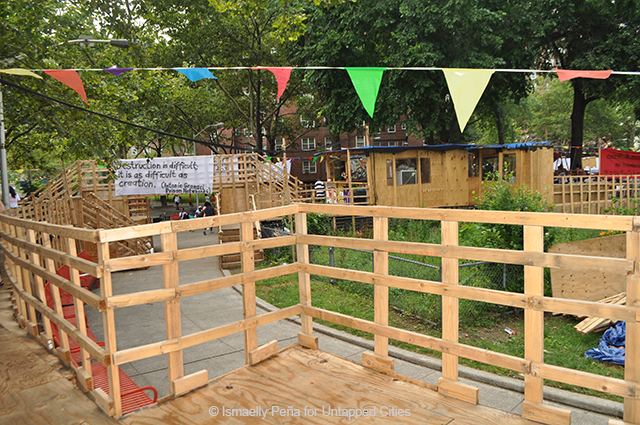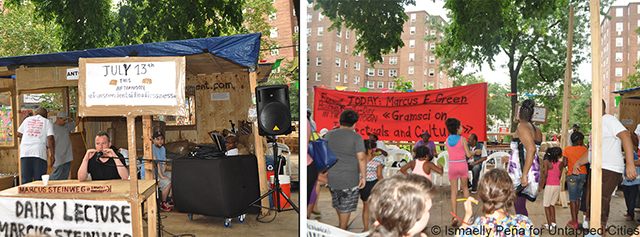
For those interested in alternatives to mainstream art galleries and museums, Thomas Hisrchhorn’s latest installation “Gramsci Monument” in the South Bronx Forest Houses presents a provocative and enriching experience. Hirschhorn recently participated in the ICP Triennial, which we reviewed in May and created the monumental installation Concordia, Concordia at Gladstone Gallery in Chelsea.
Commissioned by the renowned Dia Art Foundation, the “Gramsci Monument” is Hirchhorn’s fourth in a series of monuments that commemorate admired philosophers: Spinoza, Deleuze and Bataille and Gramsci. After a thirty-five day collaborative construction phase, the artist and the community inaugurated the Monument this past July, open now seven days a week.

The Monument is composed of a series of small pavilions connected by a serpentine platform constructed with disposable materials such as plywood, two-by-fours, tape and plastic. Reminiscent of informal settlements, Hirschhorn argues that the project is a formal re-evaluation of a classical monument. It is a low-cost, non-figurative, non-monumental temporary structure—“a time-limited Monument”. Located in the public space of the NYCHA (New York City Housing Authority) housing project, the Monument’s form, and the accompanying banners with quotes by Gramsci, intrigues anyone that passes by.
Who is Gramsci? Antonio Gramsci (1891-1937) was an Italian Marxist thinker and political theorist. He was a founding member and leader of the Communist Party of Italy until his incarceration by Mussolini’s Fascist regime. Gramsci’s major contributions to critical, educational and Marxist theory emerged from his writings during his time in prison, published as the Prison Notebooks. His writings explored the notions of socio-political control in relation to the working class. He believed the subaltern classes needed to assert themselves and be empowered against the bourgeois ruling class—accomplishing this not through revolt but through education and self-organization—in order to be liberated and create their own working class culture.
The various pavilions, which include an exhibition space, a library for the study of Gramsci’s life and theory, a radio studio, a newspaper room, computer classroom, art workshop space, a bar and stage/lecture space, all seem in one way or another to try to answer the above question or at best depict two of the most powerful Gramscian theories—cultural hegemony and the philosophy of praxis.

The Monument appears to be the a manifestation of Gramscian theory. However, in the past, Hirschhorn has stated that he is an artist, “not a social worker”. He negates the categorization of his work as community art, participatory art, activist art, educational art, or the like.
Hirschhorn’s Monument however, exists within the palpable realities and context of a low-income housing project in the South Bronx (the poorest Congressional district in the United States). Thus seeing the Gramsci Monument as simple artistic formal exploration would be a miss-reading of the Monument as it is used, occupied and appropriated by the community. This space morphs from a dance floor to a classroom or a study space on a daily basis. This Monument has created the opportunity for the community to learn about Gramsci and about themselves, to be empowered and proud. It has demystified the Bronx and housing projects for people who would not otherwise dare to visit this place.





